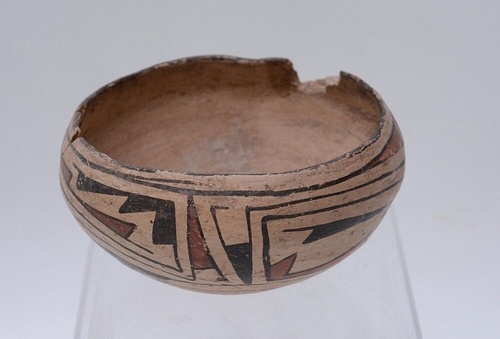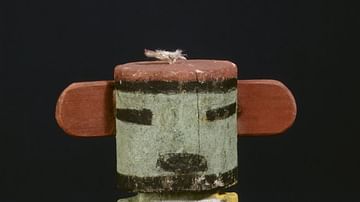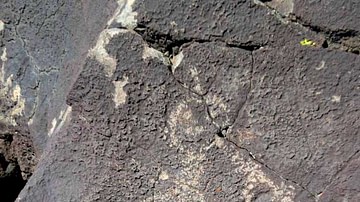
Casas Grandes or Paquimé was a major pre-Columbian city that flourished due to its extensive trading networks between c. 1150/1200-1450 CE in the northwest of present-day Chihuahua, Mexico. Casas Grandes is one of the largest and most important archaeological sites in the Oasisamerica region, and the city played a key role in the transmission of knowledge and goods between the cultures of the Pre-Columbian desert southwest and those of Mesoamerica. The construction of Casas Grandes is widely attributed to people who demonstrated the marked characteristics of the Mogollon culture, which existed from c. 200-1450 CE in what is now southern New Mexico and Arizona as well as northern Mexico, but a lively scholarly debate continues as to the exact ethnicities and origins of the peoples who lived in and founded Casas Grandes. Although only 20% of the site has been excavated and surveyed, UNESCO designated Casas Grandes as a UNESCO World Heritage Site in 1998 CE.
Geography & Origins
Situated at the foothills of the Sierra Madre Occidental Mountains and the headstream of the Casas Grandes River (Spanish: Río San Miguel), Casas Grandes or Paquimé is located in what is now the Mexican state of Chihuahua. Blessed in terms of hydrology, Casas Grandes is positioned between many rivers: The Río Bavispe and Río Yaui lie to the west of the Sierra Madre, and the Río Bravos and Río Carmen lie to the east. The city is 56 km (35 miles) south of the city of Janos and 240 km (150 miles) northwest of the city of Chihuahua. Casas Grandes' archaeological zone covers 146 hectares (361 acres), and the city covered over 750,000 m2 (185 acres) at its height. (This is 27 times larger than Chaco Canyon's Pueblo Bonito.) Casas Grandes' periphery included an estimated 10,000 additional inhabitants. Around 350 settlements of varying size existed in close proximity to Casas Grandes, but scholars and archaeologists believe that Casas Grandes' zone of political influence only extended some 30 kilometers (19 miles) from the city's center.
The region had been inhabited by indigenous peoples for thousands of years before the community at Casas Grandes began to coalesce into a sizable, organized community in the latter half of the 12th century CE. The early inhabitants were sedentary agriculturalists who built pithouses around open plazas, hunting wild game for food. Maize was the staple crop, but agave, mesquite beans, piñon, squash, and walnuts were also cultivated.
Many scholars and archaeologists characterize Casas Grandes as the largest and most complex prehistoric site in the desert southwest with high degree of sociopolitical complexity. However, the exact genesis of Casas Grandes around c. 1200 CE remains a matter of much speculation and fierce debate. Casas Grandes emerges as a dynamic polity and cultural center in a period immediately following a massive decline and dispersion in the populations of the Anasazi, Mogollon, and Hohokam between 1150-1300 CE. While some scholars explain Casas Grandes' rapid rise to prominence via a series of migrations southwards by inhabitants belonging to those cultures, others see a more localized origin for Casas Grandes' spectacular rise.
Casas Grandes' Rise & Fall
Excavations by archaeologists attest that Casas Grandes maintained much stronger ties to Mesoamerica than either the Anasazi or Hohokam cultures - copper bells, beads, the shells of marine mollusks, and the skeletons and feathers of scarlet and soldier macaws all point to a network of close trading relationships between the inhabitants of Casas Grandes and the great cities of Mesoamerica. However, it should be noted that the inhabitants of Casas Grandes, in ways reminiscent of the Hohokam culture that flourished in what is now the US state of Arizona, utilized advanced irrigation techniques and underground reservoirs to ensure the flow of freshwater to the city's inhabitants. Architectural and artistic motifs reminiscent of the Anasazi and Mogollon cultures were commonly employed too.
Casas Grandes, at its apogee, was a rich and likely cosmopolitan city ruled by a priestly elite in which it can be presumed that many inhabitants spoke several languages, worshipping in turn Mesoamerican deities like Tlaloc, Xipe Totec, and Quetzalcoatl in addition to local indigenous deities. It is estimated that Casas Grandes served a population of roughly 2,000-4,000 inhabitants, many of whom built their livelihood on trade, commerce, and artisan production. While other southwestern cultures — like the Anasazi or Ancestral Puebloan Peoples — suffered drought, famines, and widespread violence in the 12th-and-13th centuries CE, the area around Casas Grandes remained rich in natural resources, by virtue of being positioned in a fertile valley and surrounded by rivers, and a strategic location lying at the crossroads of trade between Mesoamerica and Oasisamerica.
It is believed that around the year 1340 CE, Casas Grandes was burned and subsequently rebuilt. The period between 1350-1450 CE was a period of social and structural decline despite continued population growth. Evidence for this decline is found in the hasty alteration of former public spaces into living spaces for new residences and the burial of the dead in the irrigation system. The ultimate collapse of Casas Grandes' is just as mysterious as its foundation. Several decades ago, some scholars theorized that the interruption of trade routes by the bellicose Tarascan Empire could have precipitated the decline of Casas Grandes. While it is entirely possible that a prolonged drought or even an earthquake could have contributed to its abandonment, archaeologists see the signs of human violence in Casas Grandes' ruins. Burned plaster along Casas Grandes' walls and the unearthing of hundreds of skeletons around the city point to something entirely more macabre. Ritual items and public plazas seem to have been desecrated, and animals seemingly starved to death within their own pens. When the Spanish arrived in the region a century after the abandonment of Casas Grandes, they inquired as to the fate of the city's inhabitants. According to Baltasar Obregón (b. 1534 CE), the first Spaniard to visit Casas Grandes after the conquest of the Aztecs in 1521 CE, local indigenous people told him that the former inhabitants had traveled on a six-day journey north after a brutal war, never to return to the region again.
Architecture & Art
Archaeologists believe that Casas Grandes was built on earlier structures engineered by the Mogollon people between c. 700-1200 CE, perhaps as pit houses in a village formation. Casas Grandes, in its heyday, contained 2000 rooms, making it among the largest prehistoric pueblo settlements. Its huge room blocks still rise to about 10-12 m (32-39 ft) in height, and several structures are multiple stories in height. Inhabitants later erected carefully planned but sophisticated structures in a complex layout built from adobe; stonework is apparent as well in the lining of pits, which might have been introduced to Casas Grandes by Mesoamericans.

The city includes platform mounds, vast plazas for public and mercantile use, specialized pens for the raising of macaws and turkeys, and two I-shaped ball-courts constructed in a style similar to those found in Mesoamerica. There are also effigy mounds and ceremonial mounds at Casas Grandes. One ceremonial mound is shaped like a feathered serpent, and this sacred space might have been devoted to the Mesoamerican god Quetzalcoatl. Another is shaped like a turkey or some other kind of bird. One finds a sweat bath, private courtyards, graveyards, and multiple ceremonial storage spaces throughout Casas Grandes as well. Casas Grandes has T-shaped doorways and square colonnades just like the Anasazi sites in Chaco Canyon. However, unlike other sites in the desert Southwest, Casas Grandes has no kivas (ceremonial chambers built underground).
Casas Grandes is renowned for a particular type of ceramic style utilized on pottery, bowls, and effigies: Ramos polychrome. This style is defined by a white to light-gray colored paste and surface work with fine line work in black and red colors. Striking motifs — often triangular — are combined with other shapes like circles and rectangles, which are rendered in a geometric style in black design. The artisans of Casas Grandes regularly used life forms including macaws, snakes, and humans in Ramos polychrome, giving many vessels a stunning sculptural appearance.







